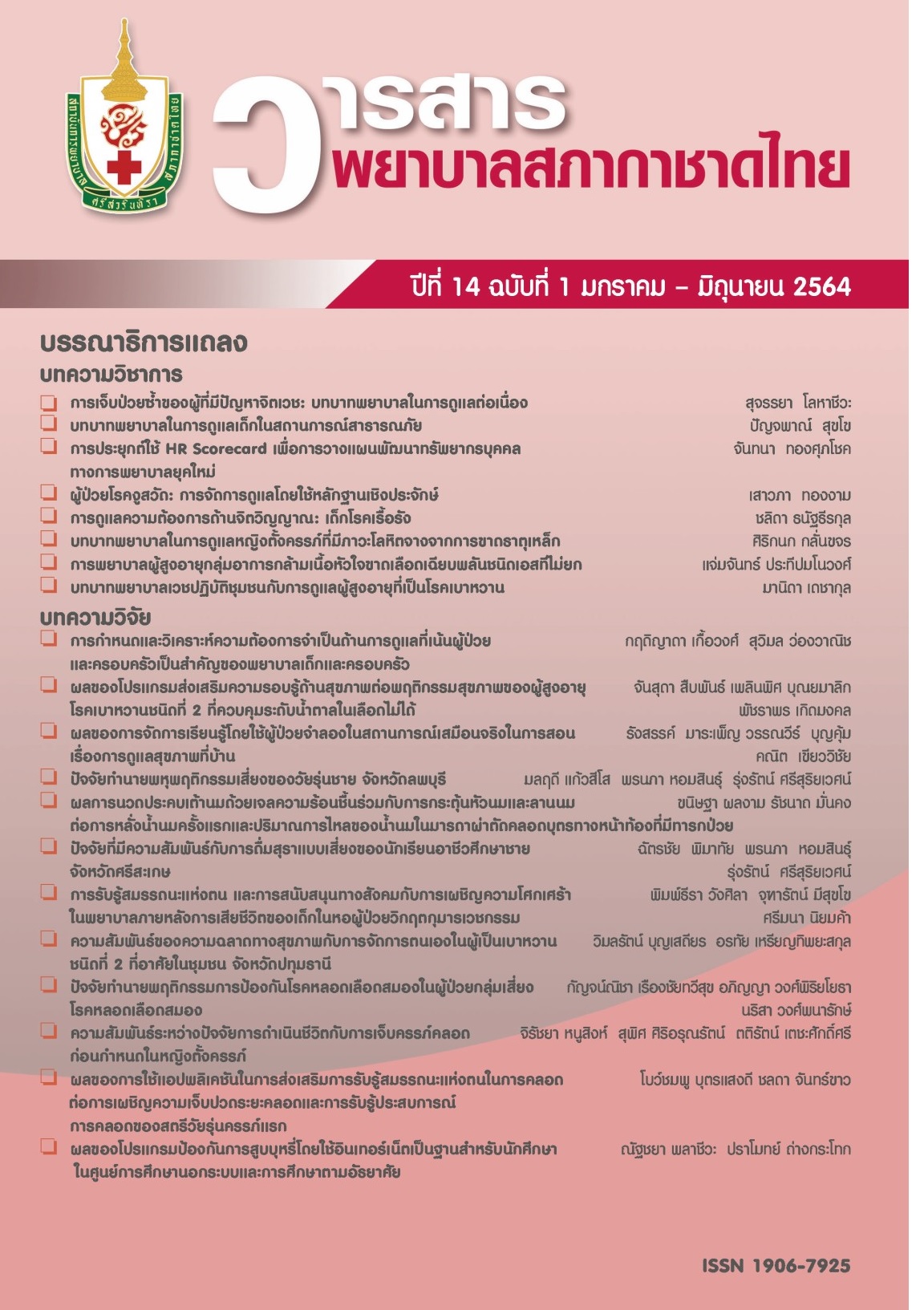Relationships between Lifestyle Factors and Premature Labor Among Pregnant Women
Keywords:
premature labor pain, working hours, secondhand smoke, leep quality, sleep quality, UTI prevention, longstandingAbstract
Relief factors related to preterm labor are important in prevention of premature contraction. The purpose of this research was to examine the relationships between lifestyle factors and premature labor in pregnant women. The subjects were 160 pregnant women who were admitted to the labor rooms of tertiary hospitals in Bangkok and Chonburi province. They were equally divided into two groups. The first consisted of 80 pregnant women with premature labor pains, and the other group comprised 80 pregnant women with full term labor pain who were selected by a simple random sampling method. Data were collected by 1) demographic questionnaire, including data related to working hours/week, longstanding, and secondhand smoke 2) the Pittsburgh sleep quality index (PSQI), and 3) prevention of UTI during pregnancy questionnaire. Data were analyzed by frequency, percent, mean, standard deviation, chi-square test and point biserial correlation coefficient statistics.
Result show sleep quality and daytime dysfunction to be significantly related to premature labor pain at alpha level .05 (X2 =9.014, df =1, p=.001, X2 =7.241, df =1, p=.006 These findings suggest that nurses and midwives should provide nursing intervention to promote sleep quality during pregnancy for the purpose of decreasing premature labor pain.
References
2. Ministry of Public Health. Public health statistics strategy and planning division. Bangkok: Ministry of Public Health; 2017. (in Thai)
3. Netthin N. Ministry of health revealed statistics of preterm pregnant women stipulated 6.4-8 thousand people/ year more than 1 Ten thousand children have to stay I.C.U. [Internet]. 2012 [cited 2018 May 3]. Available from: http://www.thanonline.com/ index.php?option=com_content&view=article&id=151171:64-8-1icu (in Thai)
4. Hoffman MC, Mazzoni SE, Wagner BD, Laudenslager ML, Ross RG. Measures of maternal stress and mood in relation to preterm birth. Obstet Gynecol 2016;127(3):545-52.
5. Stylianou-Riga P, Kouis P, Kinni P, Rigas A, Papadouri T, Yiallouros PK, et al. Maternal socioeconomic factors and the risk of premature birth and low birth weight in Cyprus: a case-control study. Reprod Health 2018;15(1):157. doi: 10.1186/s12978-018-0603-7
6. Cui H, Gong TT, Liu CX, Wu QJ. Associations between passive maternal smoking during pregnancy and preterm birth: evidence from a meta-analysis of observational studies. PLoS One 2016;11(1):e0147848. doi: 10.1371/journal.pone.0147848
7. Palmer KT, Bonzini M, Harris EC, Linaker C, Bonde JP. Work activities and risk of prematurity, low birth weight and pre-eclampsia: an updated review with meta-analysis. Occup Environ Med 2013;70(4):213-22.
8. Sharma R, Biedenharn KR, Fedor JM, Agarwal A. Lifestyle factors and reproductive health: taking control of your fertility. Reprod Biol Endocrinol 2013;11:66. doi: 10.1186/1477-7827-11-66
9. Khader YS, Al-Akour N, AlZubi IM, Lataifeh I. The association between second hand smoke and low birth weight and preterm delivery. Matern Child Health J 2011;15(4):453-9.
10. Okun ML, Schetter CD, Glynn LM. Poor sleep quality is associated with preterm birth. Sleep 2011;34(11):1493-8.
11. Pillitteri A. Psychological and Physical Changes of Pregnancy. In: Pillitteri A, editor. Maternal & child health nursing: care of the childbearing & childrearing family. 6th ed. Philadelphia: Lippincott Williams & Wilkins; 2010. p. 217-43.
12. Thanasombat K. Urinary tract infection in pregnant women. Journal of Hua Chiew Chalermprakiet University 2013;16(32):141-56. (in Thai)
13. Parel CP, Caldito GC, Ferrer PL, De Guzman GG, Sinsioco CS, Tan RH. Papers on survey research methodology sampling design and procedures. Social survey research design. Philippines: Philippine Social Science Council; 1973.
14. Jirapramukpitak T, Tanchaiswad W. Sleep disturbances among nurses of Songklanagarind hospital. J Psychiatr Assoc Thailand 1994;42(3):122-31. (in Thai)
15. Saetang K. Effects of prevention program on recurrent urinary tract infections on preventive behaviors of urinary tract infections of pregnant women [Thesis]. Chonburi: Burapha University; 2019. (in Thai)
16. Fuchs F, Monet B, Ducruet T, Chaillet N, Audibert F. Effect of maternal age on the risk of preterm birth: a large cohort study. PloS one 2018;13(1):e0191002. doi: 10.1371/journal.pone.0191002
17. Chang HY, Lai YH, Jensen MP, Shun SC, Hsiao FH, Lee CN, Yang YL. Factors associated with low back pain changes during the third trimester of pregnancy. J Adv Nurs 2014;70(5):1054-64.
18. Baratte-Beebe KR, Lee K. Sources of midsleep awakenings in childbearing women. Clin Nurs Res 1999;8(4):386-97.
Downloads
Published
Issue
Section
License
เนื้อหาบทความหรือข้อคิดเห็นต่างๆ ในวารสารพยาบาลสภากาชาดไทยนี้ เป็นความคิดเห็นของผู้เขียนบทความ ไม่ใช่ความเห็นของกองบรรณาธิการ หรือสถาบันการพยาบาลศรีสวรินทิรา สภากาชาดไทย






